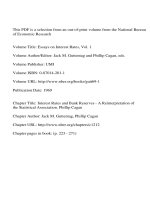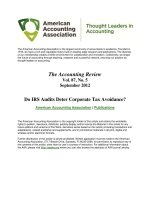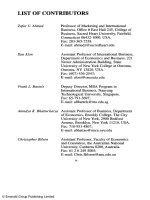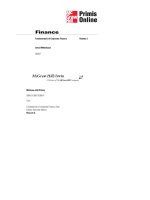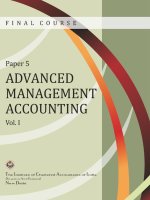YTC Price Action Trader vol 6
Bạn đang xem bản rút gọn của tài liệu. Xem và tải ngay bản đầy đủ của tài liệu tại đây (485.33 KB, 34 trang )
Volume Six - Conclusion
YTC Price Action Trader
by Lance Beggs
Published by:
LB68 Publishing
PO Box 4097
Kirwan QLD 4817
Copyright © 2010. Lance Beggs. All rights reserved.
No part of this publication may be reproduced or transmitted in any form or by any means,
electronic or mechanical, without written permission from the publisher, except as permitted by
Australian Copyright Laws.
First Edition, 2010.
Published in Australia.
© Copyright 2010. Lance Beggs, www.YourTradingCoach.com. All Rights Reserved
2
No Reprint Rights
While other YTC eBooks ( specifically authorise
Free Reprint Rights, this does NOT apply to the YTC Price Action Trader series.
The YTC Price Action Trader series is subject to standard copyright laws.
You are not authorised to share this eBook via electronic means, including forwarding a copy to
your friends, sharing it with your newsletter subscribers, hosting it on your website, or including
it as a free bonus with any other trading product.
Affiliate Sales
If you find this six-volume series of ebooks to be of great value and wish to offer it for sale to
your own customers or website/blog readers, I encourage you to sign up as an affiliate.
More information, including details on affiliate commissions, is listed at the following webpage:
www.YourTradingCoach.com/Affiliate.html
© Copyright 2010. Lance Beggs, www.YourTradingCoach.com. All Rights Reserved
3
Disclaimer
The information provided within the YTC Price Action Trader ebook series and any supporting documents, websites
and emails is GENERAL COMMENT ONLY, for the purposes of information and education. We don't know you
so any information we provide does not take into account your individual circumstances, and should NOT be
considered advice. Before investing or trading on the basis of this material, both the author and publisher encourage
you to first SEEK PROFESSIONAL ADVICE with regard to whether or not it is appropriate to your own
particular financial circumstances, needs and objectives.
The author and publisher believe the information provided is correct. However we are not liable for any loss, claims,
or damage incurred by any person, due to any errors or omissions, or as a consequence of the use or reliance on any
information contained within the YTC Price Action Trader ebook series and any supporting documents, websites
and emails.
Reference to any market, trading timeframe, analysis style or trading technique is for the purpose of information and
education only. They are not to be considered a recommendation as being appropriate to your circumstances or
needs.
All charting platforms and chart layouts (including timeframes, indicators and parameters) used within this ebook
series are being used to demonstrate and explain a trading concept, for the purposes of information and education
only. These charting platforms and chart layouts are in no way recommended as being suitable for your trading
purposes.
Charts, setups and trade examples shown throughout this product have been chosen in order to provide the best
possible demonstration of concept, for information and education purposes. They were not necessarily traded live by
the author.
U.S. Government Required Disclaimer:
Commodity Futures Trading and Options trading has large potential rewards, but also large potential risk. You must
be aware of the risks and be willing to accept them in order to invest in the futures and options markets. Don't trade
with money you can't afford to lose. This is neither a solicitation nor an offer to Buy/Sell futures or options. No
representation is being made that any account will or is likely to achieve profits or losses similar to those discussed
on this web site. The past performance of any trading system or methodology is not necessarily indicative of future
results.
CFTC RULE 4.41 - HYPOTHETICAL OR SIMULATED PERFORMANCE RESULTS HAVE CERTAIN
LIMITATIONS. UNLIKE AN ACTUAL PERFORMANCE RECORD, SIMULATED RESULTS DO NOT
REPRESENT ACTUAL TRADING. ALSO, SINCE THE TRADES HAVE NOT BEEN EXECUTED, THE
RESULTS MAY HAVE UNDER-OR-OVER COMPENSATED FOR THE IMPACT, IF ANY, OF CERTAIN
MARKET FACTORS, SUCH AS LACK OF LIQUIDITY. SIMULATED TRADING PROGRAMS IN GENERAL
ARE ALSO SUBJECT TO THE FACT THAT THEY ARE DESIGNED WITH THE BENEFIT OF HINDSIGHT.
NO REPRESENTATION IS BEING MADE THAT ANY ACCOUNT WILL OR IS LIKELY TO ACHIEVE
PROFIT OR LOSSES SIMILAR TO THOSE SHOWN
© Copyright 2010. Lance Beggs, www.YourTradingCoach.com. All Rights Reserved
4
About the Author
Lance Beggs is a full time day-trader with a current preference for forex, FX futures and eminifutures markets. His style of trading is discretionary, operating in the direction of short-term
sentiment within a framework of support and resistance.
As an ex-military helicopter pilot and aviation safety specialist, Lance has an interest in applying
the lessons and philosophy of aviation safety to the trading environment, through study in human
factors, risk management and crew resource management.
He is the founder and chief contributor to , which aims to
provide quality trading education and resources with an emphasis on the ‘less sexy’ but more
important aspects of trading – business management, risk management, money management and
trading psychology.
Lance can be contacted via
© Copyright 2010. Lance Beggs, www.YourTradingCoach.com. All Rights Reserved
5
“Now this is not the end.
It is not even the beginning of the end. But it
is, perhaps, the end of the beginning.”
…Winston Churchill
© Copyright 2010. Lance Beggs, www.YourTradingCoach.com. All Rights Reserved
6
Table of Contents
Volume One – Introduction
Chapter One – Introduction
15 1.1 – Introduction………………………………………………………………...
17 1.2 – Scope – Strategy, Markets & Timeframes………………………………….
19 1.3 – Acknowledgments………………………………………………………….
19 1.4 – Prerequisites………………………………………………………………...
20 1.5 – Feedback……………………………………………………………………
20 1.6 – Contents Overview…………………………………………………………
Volume Two – Markets and Market Analysis
Chapter Two – Principles of Markets
15 2.1 – Principles of Markets……………………………………………………….
16 2.2 – The Reality of the Markets…………………………………………………
16
2.2.1 – Trading the Shadows……………………………………………..
19
2.2.2 – Cause and Effect………………………………………………….
22
2.2.3 – What is Price?…………………………………………………….
23
2.2.4 – How Does Price Move? ………………………………………….
32
2.2.5 – What are Markets…………………………………………………
37
2.2.6 – Summary – The Reality of the Markets…………………………...
38 2.3 – The Reality of the Trading Game…………………………………………..
38
2.3.1 – How Do We Profit? ………………………………………………
39
2.3.2 – Analysis for Profit…………………………………………………
43 2.4 – Effective vs Ineffective Trading Strategies and Systems…………………..
50
2.4.1 – Principles of my Effective Strategy……………………………….
52 2.5 – Conclusion.…………………………………………………………………
Chapter Three – Market Analysis
54 3.1 – Introduction to Market Analysis…………………………………………...
54
3.1.1 – The Aim of our Market Analysis………………………………….
55
3.1.2 – Subjectivity vs Objectivity in Market Analysis……………………
57 3.2 – Past Market Analysis……………………………………………………….
57
3.2.1 – Support and Resistance……………………………………………
© Copyright 2010. Lance Beggs, www.YourTradingCoach.com. All Rights Reserved
7
72
79
90
113
113
116
145
153
156
160
160
161
165
172
173
180
184
186
186
186
189
3.2.2 – Multiple Timeframe Analysis……………………………………...
3.2.3 – Market Structure…………………………………………………..
3.2.4 – Trends……………………………………………………………..
3.3 – Future Trend………………………………………………………………...
3.3.1 – Strength and Weakness……………………………………………
3.3.2 – Identifying Strength and Weakness……………………………….
3.3.3 – Principles of Future Trend Direction…………………………….
3.3.4 – Visualising the Future…………………………………………….
3.3.5 – What Happens After S/R Holds? …………………………………
3.4 – Initial Market Analysis Process…………………………………………….
3.4.1 – Initial Market Analysis Process Summary………………..………
3.4.2 – Initial Market Analysis Checklist...……………………………….
3.4.3 – Initial Market Analysis Example………………………………….
3.5 – Ongoing Market Analysis – Theory………………………………………...
3.5.1 – Determine Candle Pattern Sentiment…………………………….
3.5.2 – Consider the Context……………………………………………...
3.5.3 – Does it Support our Premise? ……………………………………
3.6 – Ongoing Market Analysis Process………………………………………….
3.6.1 – Ongoing Market Analysis Process Summary……………………..
3.6.2 – Ongoing Market Analysis Checklist………………………………
3.6.3 – Ongoing Market Analysis Example………………………………
3.7 – Practice……………………………………………………………………..
200
3.7.1 – Market Structure Journal…………………………………………
201
202
3.8 – Conclusion………………………………………………………………….
3.9 – Addendum to Chapter 3 – Alternative Questions for the Conduct of Price
203
Action Analysis…………………………………………………………….
Volume Three – Trading Strategy
Chapter Four – Strategy – YTC Price Action Trader
15 4.1 – Strategy – YTC Price Action Trader……………………………………....
15 4.2 – Setup Concept……………………………………………………………..
15
4.2.1 – The Expectancy Formula………………………………………..
17
4.2.2 – Principles behind the YTC Price Action Trader Setup Locations.
25 4.3 – YTC Price Action Trader Setups…………………………………………..
25
4.3.1 – Setup Definition…………………………………………………..
41
4.3.2 – Setups Appropriate for each Particular Market Environment…...
54
4.3.3 – Revisiting the Initial Market Analysis Process and Checklist……
56
4.3.4 – More Action – Trading In-between Setup Areas…………………
56
4.3.5 – When Price Enters Setup Areas…………………………………..
© Copyright 2010. Lance Beggs, www.YourTradingCoach.com. All Rights Reserved
8
57
57
64
70
99
119
119
120
123
123
4.4 – Trading the Setups…………………………………………………………
4.4.1 – Stop Placement………………………………………………….
4.4.2 – Targets…………………………………………………………..
4.4.3 – Entry…………………………………………………………….
4.4.4 – Trade Management……………………………………………..
4.5 – The Trading Process………………………………………………………
4.5.1 – Trading Process Diagram………………………………………
4.5.2 – Trading Process Checklist………………………………………
4.6 – Practice……………………………………………………………………
4.7 – Conclusion………………………………………………………………...
Chapter Five – Trade Examples
126
5.1 – Trade Example 1 – BPB – T1 & T2 Achieved……………………………
138
5.2 – Trade Example 2 – PB – T1 Achieved – Part Two Worked Exit…………
5.3 – Trade Examples 3 – BOF, BPB, TST – Sideways Trend within another
152
Sideways Trend………………………………………..…….……………
167
5.4 – Trade Example 4 – CPB – T1 Achieved – T2 Trailed……….……………
177
5.5 – Trade Example 5 – TST – Part 1 Stopped Breakeven - Part 2 Trailed……
189
5.6 – Trade Example 6 – BOF – T1 & T2 Achieved……………………………
5.7 – Trade Example 7 – TST – Part 1 Scratched, Re-entered & Stopped Out –
200
Part 2 Stopped Out………………..……………………………………....
213
5.8 – Trade Example 8 – PB – Scratched – No Re-entry……………………….
225
5.9 – Trade Example 9 – CPB – T1 & T2 Achieved……………………………
5.10 – Trade Example 10 – TST – Scratched & Reversed - PB – T1 Achieved –
235
Part 2 Stopped (Trail)..……..…………………………………….………...
250
5.11 – Trade Example Summary Notes………………………………….………
Chapter Six – Other Markets, Other Timeframes
253
6.1 – Other Markets, Other Timeframes………………………………………...
255
6.2 – Examples – Forex………………………………………………………….
261
6.2.1 – Additional Forex Considerations………………………………..
264
6.3 – Examples – Emini Futures………………………………………………...
269
6.3.1 – Additional Emini Futures Considerations……………………….
271
6.4 – Examples – Stocks & ETFs……………………………………………….
275
6.4.1 – Additional Stock & ETF Considerations………………………..
276
6.5 – Conclusion………………………………………………………………...
© Copyright 2010. Lance Beggs, www.YourTradingCoach.com. All Rights Reserved
9
Volume Four – Your Trading Business
Chapter Seven – Money Management
15 7.1 – Ensuring Survival………………………………………………………….
15 7.2 – Financial Survival………………………………………………………….
15 7.3 – Money Management……………………………………………………….
Chapter Eight – Contingency Management
8.1 – Contingency Management…………………………………………………
8.1.1 – Contingency Management……………………………………….
26
26
Chapter Nine – Goals & Targets
30 9.1 – What Win% Should You Expect?................................................................
31 9.2 – Ok… If I Absolutely Must!..........................................................................
31 9.3 – Stats………………………………………………………………………..
32 9.4 – Another Option – For the Consistently Profitable………………………...
Chapter Ten – Trading Psychology – A Practical Approach
37 10.1 – Personal Survival…………………………………………………………
37 10.2 – Prerequisites for Survival………………………………………………...
42 10.3 – Mastery of Trading Psychology………………………………………….
42
10.3.1 – Focus on Process………………………………………………
45
10.3.2 – Peak Performance Mindset…………………………………….
53 10.4 – Maintenance of Peak Physical Condition………………………………..
58 10.5 – Psych Wrap-Up…………………………………………………………..
58 10.6 – Additional Study…………………………………………………………
Chapter Eleven – Trading Platform Setup
11.1 – Trading Platform Setup…………………………………………………..
60
Chapter Twelve – Trading Plan
65 12.1 – Trading Plan………………………………………………………………
67 12.2 – Trading Plan Template……………………………………………………
69 12.3 – Trading Plan – Explanatory Notes………………………………………..
69
12.3.1 – Cover Page……………………………………………………..
69
12.3.2 – Preface………………………………………………………….
70
12.3.3 – Introduction……………………………………………………..
70
12.3.4 – The Trader………………………………………………………
71
12.3.5 – The Trading Business……………………………………………
74
12.3.6 – The Trading Process…………………………………………….
© Copyright 2010. Lance Beggs, www.YourTradingCoach.com. All Rights Reserved
10
12.3.7 – Annexes…………………………………………………………
76
Chapter Thirteen – Procedures Manual
13.1 – Procedures Manual………………………………………………………..
13.2 – Sample Procedures Manual……………………………………………….
78
78
Chapter Fourteen – Additional Documentation
106 14.1 – Additional Documentation……………………………………………….
106 14.2 – Trading Journal Spreadsheet……………………………………………..
106 14.3 – Trading Log………………………………………………………………
108 14.4 – Motivation Journal………………………………………………………..
108 14.5 – Lessons Learnt Journal……………………………………………………
109 14.6 – Market Structure Journal………………………………………………….
110 14.7 – Trades Journal…………………………………………………………….
Volume Five – Trader Development
Chapter Fifteen – The Journey
15.1 – FACT: Most Readers Will Fail to Achieve Consistent Profitability…….
15.2 – The Journey………………………………………………………………
15
17
Chapter Sixteen – The Learning Process
20 16.1 – Effective Learning……………………………………………………….
20 16.2 – Deliberate Practice……………………………………………………….
21 16.3 – Trade-Record-Review-Improve………………………………………….
22 16.4 – Deliberate Practice Tools and Techniques……………………………….
22
16.4.1 – Defined Trading Procedures…………………………………...
22
16.4.2 – Trading Logs and Journals…………………………………….
22
16.4.3 – Documented Review Process…………………………………..
23
16.4.4 – Market Replay………………………………………………….
26
16.4.5 – Market Replay Alternatives…………………………………….
26
16.4.6 – Peer Review……………………………………………………
Chapter Seventeen – Taking Action
29 17.1 – Taking Action…………………………………………………………….
29 17.2 – The Development Stages…………………………………………………
30
17.2.1 – Stage 1 – Establish Your Foundation…………………………..
33
17.2.2 – Stage 2 – Simulator Environment………………………………
34
17.2.3 – Stage 3 – Live Environment – Minimum Size…………………..
© Copyright 2010. Lance Beggs, www.YourTradingCoach.com. All Rights Reserved
11
35
35
36
37
41
41
17.2.4 – Stage 4 – Live Environment – Increasing Size…………………
17.2.5 – As You Progress………………………………………………..
17.3 – Taking Action – Alternate Strategies…………………………………….
17.4 – Challenges and Difficulties………………………………………………
17.5 – The Target………………………………………………………………..
17.6 – Additional Study………………………………………………………….
Volume Six – Conclusion
Chapter Fourteen – Conclusion
15 18.1 – Summary………………………………………………………………….
15
18.1.1 – Principles of Markets –Summary……………………………….
17
18.1.2 – Market Analysis –Summary…………………………………….
20
18.1.3 – Trading Strategy –Summary……………………………………
29
18.1.4 – Setups Poster……………………………………………………
30
18.1.5 – The Learning Process –Summary………………………………
31 18.2 – For Those Concerned That It Appears Too Simple……………………….
32 18.3 – And For Those Who Perceive It As Too Complex……………………….
32 18.4 – Take Action……………………………………………………………….
33 18.5 – Wrap Up…………………………………………………………………..
33 18.6 – Supplementary Resources…………………………………………………
© Copyright 2010. Lance Beggs, www.YourTradingCoach.com. All Rights Reserved
12
VOLUME SIX
CONCLUSION
© Copyright 2010. Lance Beggs, www.YourTradingCoach.com. All Rights Reserved
13
Chapter Eighteen – Conclusion
© Copyright 2010. Lance Beggs, www.YourTradingCoach.com. All Rights Reserved
14
18.1- Summary
18.1.1 – Principles of Markets – Summary
Markets are traders making trading decisions.
Price movement is a result of supply/demand imbalance. And the supply/demand imbalance is
created by the traders’ sense of urgency to transact.
Price rises while demand is greater than supply, and while those buyers are willing to pay
higher prices.
Price rises until we run out of buyers, or until supply increases sufficiently to absorb all
the demand.
Price falls while supply is greater than demand, and while those sellers are willing to sell
at lower prices.
Price falls until we run out of sellers, or until demand increases to the point it absorbs all
the supply.
Price moves with changes in the forces of supply and demand. Supply and demand change as the
sentiment of the crowd changes. And the sentiment of the crowd changes with changes in the
bullish or bearish sentiment of the market participants.
Trading is not about the fundamentals or technicals. It’s about people… and the decisions they
make about market direction.
Price moves as a collective result of all traders’ bullish or bearish sentiment and their decisions
to act in the market (buy or sell).
Learn to view all price movement from the perspective of other traders, and how the price
movement influences their decision making.
The aim of your analysis then MUST be the following:
To buy at areas where you KNOW others will buy after you, because their buying will
create the net orderflow or bullish pressure to drive prices higher, allowing you
opportunity to profit, or
© Copyright 2010. Lance Beggs, www.YourTradingCoach.com. All Rights Reserved
15
To sell at areas where you KNOW others will sell after you, because their selling will
create the net orderflow or bearish pressure to drive prices lower, allowing you
opportunity to profit.
Or more simply; buy at areas where others will buy after you, and sell at areas where others will
sell after you.
To do that, your analysis must focus on areas of trader decisions.
What are other traders thinking? Where will they be making their trading decisions?
Identify areas at which others will be making buying decisions, and you can profit.
Identify areas at which others will be making selling decisions, and you can profit.
Individual trader decisions are unknown. However we can, through our analysis, identify areas
where significant groups of traders will be under extreme stress, and therefore feel forced to act
in a reasonably predictable manner.
We aim to enter before or at the point of maximum stress, where traders are coming to accept
they’re wrong.
Their decision to exit is a means of relieving themselves of stress. This creates orderflow that
takes our position to profit (provided of course you manage the trade well).
© Copyright 2010. Lance Beggs, www.YourTradingCoach.com. All Rights Reserved
16
18.1.2 – Market Analysis – Summary
Initial Market Analysis Process Summary
Figure 18.1 - Initial Market Analysis Process
© Copyright 2010. Lance Beggs, www.YourTradingCoach.com. All Rights Reserved
17
Principles of Future Trend Direction
Within the S/R framework:
First Principle – We expect an up or down trend to continue in its current state until the
next S/R barrier, unless displaying evidence of weakness within the trend.
Second Principle - When an up or down trend shows evidence of weakness, we expect a
higher likelihood of a complex correction* rather than a reversal, until such time as the
market shows both price acceptance and strength in the new trend direction.
(* a complex correction being one of extended duration, or multiple swings)
Third Principle – A sideways trend within the framework is expected to continue in its
current state, unless displaying evidence of strength towards the range boundary.
Fourth Principle - When a sideways trend shows evidence of strength towards the range
boundary, we expect a break of the boundary. We observe the behaviour of price postbreakout for clues as to future direction:
Weakness following the breakout – the expectation is for a breakout failure and
reversal back within the trading range
Weakness on the pullback – the expectation is for a breakout pullback and
continuation.
At the edges of the S/R framework:
Fifth Principle – We expect a test of our framework S/R to hold, unless strength is
displayed on approach to the S/R boundary.
Sixth Principle - If strength is shown on an approach to an S/R barrier, we expect a
breakout and watch the behaviour of price post-breakout for clues as to future direction:
Weakness following the breakout – the expectation is for a breakout failure and
reversal back through the area of S/R.
Weakness on the pullback – the expectation is for a breakout pullback and
continuation.
© Copyright 2010. Lance Beggs, www.YourTradingCoach.com. All Rights Reserved
18
Ongoing Market Analysis Process Summary
Figure 18.2- Ongoing Market Analysis Process
© Copyright 2010. Lance Beggs, www.YourTradingCoach.com. All Rights Reserved
19
18.1.3 – Trading Strategy – Summary
Find the areas on a chart where other traders will make trading decisions and you’ve got yourself
an edge.
Enter at or before the change of net order flow and you’ve got a great opportunity to profit
(provided you manage the trade well).
Our trading approach therefore needs to be based on this fundamental understanding of how to
profit from the markets:
We identify areas at which sufficient numbers of traders will be experiencing stress, and
will make trading decisions to relieve them of that stress, and then act before or with
them in order to profit from the resultant orderflow.
We aim to find places on the chart where other traders are fighting the bias. We identify the areas
where they realise they’re wrong and are forced to exit.
There are two primary concepts behind all my setups – fading weakness and fading trapped
traders.
Identify weakness. Identify trapped traders. Fade the weakness and be part of the orderflow
which springs the trap.
Figure 18.3 - Test Setup (TST)
© Copyright 2010. Lance Beggs, www.YourTradingCoach.com. All Rights Reserved
20
Figure 18.4 - Breakout Failure Setup (BOF)
Figure 18.5 - Breakout Pullback Setup (BPB)
© Copyright 2010. Lance Beggs, www.YourTradingCoach.com. All Rights Reserved
21
Figure 18.6 - PB Setup
Figure 18.7 - CPB Setup
© Copyright 2010. Lance Beggs, www.YourTradingCoach.com. All Rights Reserved
22
Setups Appropriate for each Particular Market Environment:
Steady trend environment:
Higher Probability
PB and CPB
Weakening trend environment
Higher Probability
CPB
PB if they break a previous swing low (uptrend) or swing high (downtrend)
Lower Probability
Standard PB (single leg; not breaking any prior swing low (uptrend) or swing
high (downtrend))
Counter-trend TST or BOF of swing high (uptrend) or swing low (downtrend)
Within a Sideways Trading Range with a clear intra-range trend
Lower Probability
PB and CPB
Approaching higher timeframe S/R or range S/R, with no sign of potential breakout
Higher Probability
TST
Approaching higher timeframe S/R or range S/R, with strength showing signs of potential
breakout
Higher Probability
BOF or BPB
© Copyright 2010. Lance Beggs, www.YourTradingCoach.com. All Rights Reserved
23
Figure 18.8 - Trading Process
Lower Timeframe Entry:
Figure 18.9 - Entry Decision Stall or Trigger
© Copyright 2010. Lance Beggs, www.YourTradingCoach.com. All Rights Reserved
24
Pattern-based trigger examples include:
1) Any standard candlestick reversal pattern
2) Any standard price bar reversal pattern
3) Any trap pattern which proves the loser wrong
a) spike & ledge
b) double top or bottom
c) spring or upthrust
d) 3-swing retrace
e) 123 top or bottom
f) test of breakout point
g) expansion bar
Refer to the video series at:
/>
Candlestick Reversal
Patterns
Refer to the video series at:
/>
Price Bar Reversal Patterns
Spike and Ledge (bullish)
Price spike down, quickly
reversed, then unable to meet
lows again. Trigger = break
above ledge.
Spike and Ledge (bearish)
Price spike up, quickly
reversed, then unable to meet
highs again. Trigger = break
below ledge.
Figure 18.10 - Lower Timeframe Triggers (1 of 4)
© Copyright 2010. Lance Beggs, www.YourTradingCoach.com. All Rights Reserved
25


